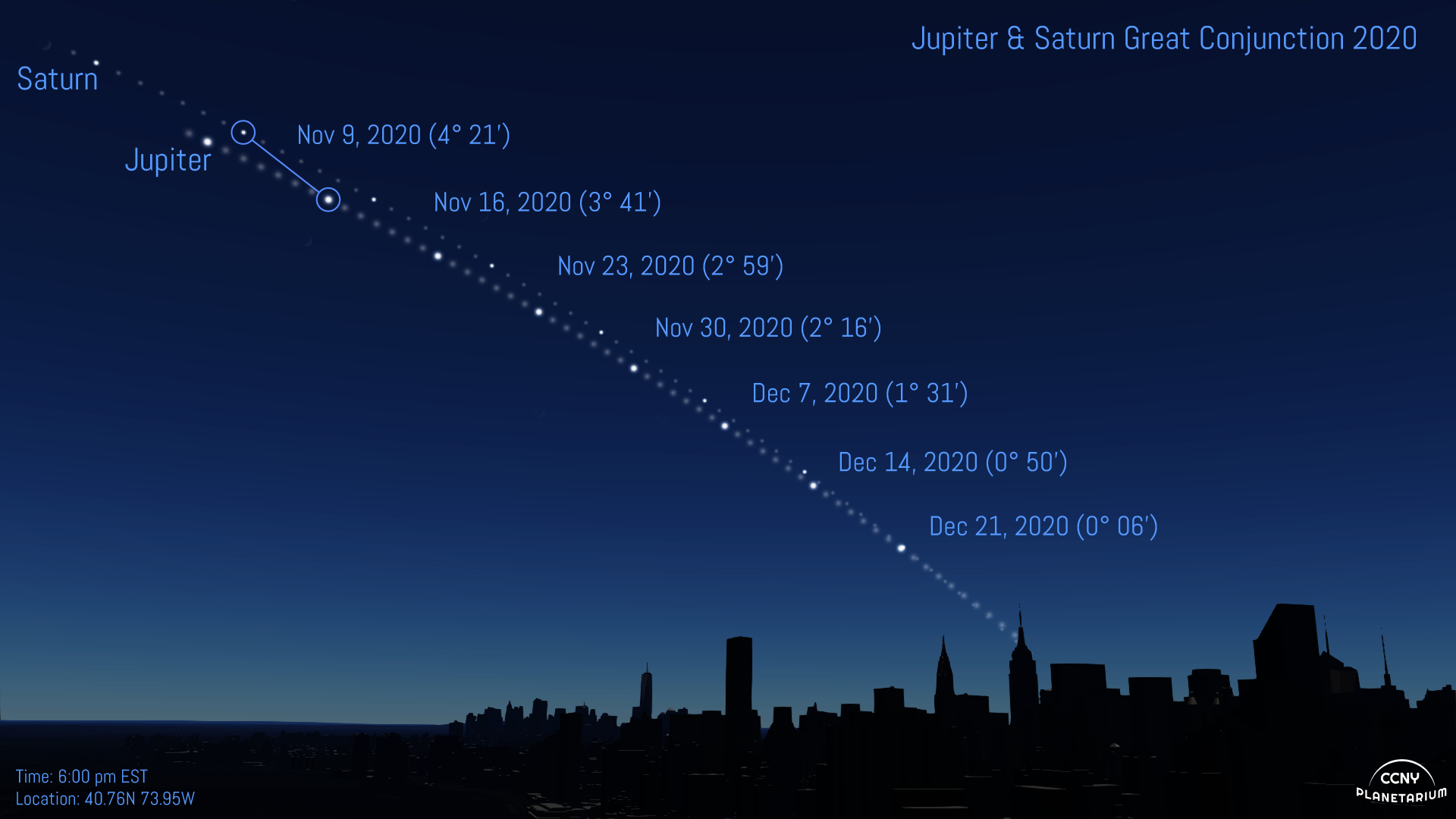The Jupiter Saturn Great Conjunction of 2020
• James Hedberg
Introduction
Inspired by some awkward (and astronomically impossible) images online of the Jupiter-Saturn Conjunction of 2020, we’ve put together a few of our own for folks to use and share. These are all made with NASA grade planetary data and should represent, to extreme precision, what would appear in the sky (assuming it was perfect weather every night and you had a great camera and could trek out to these locations). In short, if you see one that looks like a big V over a pretty sunset, you should know it was essentially made up - i.e. a photoshop job.
The Basic Scene
Below is an image showing about 60 days of consecutive images, superimposed on each other. Every day is shown, with highlights each week. Over the course of the months shown, their apparent separation in the sky becomes smaller, eventually reaching a minimum on Dec 21st. This view is looking downtown on the island of Manhattan at 6 PM EST.

We can animate the view over time as well, so that the arrow of time can be clearly seen

The orientation of the planets with respect to the earth will depend on the viewers exact location, so, we’ve prepared a few images showing what the sky would look like from various places on Earth. Here are three different locations showing how the general path of the planets would be:

| Location | Lat/Long | Time of Day | Stacked Image (w/ dates) | Stacked Image (no labels) | Animated GIF |
|---|---|---|---|---|---|
| NYC, NY | 40.77 N, 73.97 W | 23:00 GMT / 6pm EST | png (1920x1080) | png (1920x1080) | gif (1920x1080) |
| Santa Fe, NM | 35.66 N, 105.91 W | 1:00 GMT / 6pm MST | png (1920x1080) | png (1920x1080) | gif (1920x1080) |
| Seattle, WA | 47.5 N, 122.5W | 1:30 GMT | png (1920x1080) | png (1920x1080) | gif (1920x1080) |
| Argolic Gulf, Greece | 37.45 N, 22.77 E | 17:00 GMT | png (1920x1080) | png (1920x1080) | gif (1920x1080) |
| Table Mountain, South Africa | 33.92 S, 18.46 E | 19:00 GMT | png (1920x1080) | png (1920x1080) | gif (1920x1080) |
Technical Info
Since few things bring out the nit-picking in folks like special astronomical events do, here are some technical details of the above images in case anyone asks.
All images are simulated and rendered with OpenSpace. A camera location is given in the Lat/Long column. The stacked images are all snapshots of the night sky (stars excluded for clarity) at the given time. Also not included in the images are advanced atmospheric effects and changing light due to sunset, which should happen about an hour before the images are taken. (Angular separation values do include atmospheric effects.)
Thanks to Prof. Emily Rice for helpful comments in the preparation of the NYC skyline image.
The 3d Buildings of NYC are from NYC DOITT.
And, while we’re delighted to see these being used (as opposed to other, mildly misleading images out there), we’d also be delighted with a credit line somewhere, i.e. [Credit: J.Hedberg/CCNYPlanetarium] is certainly reasonable. Thx.
One more location
Let’s also take a trip a few million miles from Earth and see what this whole event looks like from space. Here we have 100 consecutive days showing the planets in motion around the sun. Notice how on the 21st of December, the three planets, Earth, Jupiter, and Saturn, are all along a line. That’s the conjunction! It happens regularly, but this year, it’s special. They are lined up better than they have been since 1623.

About the author
Dr. Hedberg studied the ancient cosmologies of Ptolemy, Tycho, and Kepler as an undergrad at St. John’s College (Santa Fe) as part of the Program’s Mathematics tutorial, though the college didn’t have this beautiful tool when he attended there. Since then, his work in programming and science visualization sometimes takes delightful detours into the past, present and future.
Tired of the normal #mta map? Let Newton make one. Here's some #creativecoding with @p5xjs that generates new (but impractical) #subway maps based on the inverse square law of gravity. Write up and live version here: https://t.co/vQfIJl4DBA pic.twitter.com/ocWIRp61If
— James Hedberg (@jameshedberg) July 1, 2020